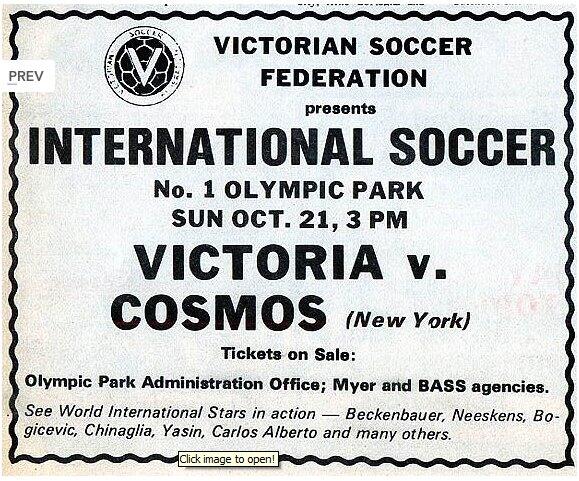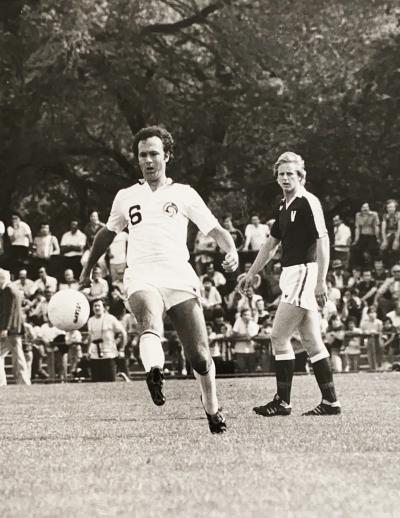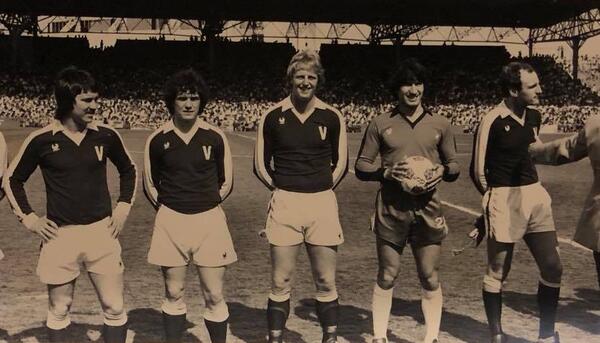Tony Persoglia looks back to this day in 1979, where Olympic Park and Victoria hosted Der Kaiser and New York Cosmos.
It may be 41 years since Victoria entertained New York Cosmos at Olympic Park, but for those involved, it seems like only yesterday. The visit of Cosmos continued a long tradition of foreign clubs touring Australian shores, a practice which gathered momentum after Australia’s international ban from FIFA was lifted in 1963. From Manchester United to AS Roma, Dinamo Moscow to Chelsea, crowds flocked to see the best clubs from around the world showcase their talents against Australia and each of the state’s representative teams. But as the 1970’s drew to a close and the world of football entered the corporate era, the New York Cosmos would prove a significant match in the history of Victorian representative football.

Chris Bambridge, fresh from a stellar season as a referee in the fledgling National Soccer League, would officiate the contest and recalls a squad laden with world-class talent, “there were eight players who had played in the West Germany and Argentina World Cup Finals. Names like Carlos Alberto, Marinho Chagas, Giorgio Chinaglia, Johan Neeskens, Wim Rijsbergen and Franz Beckenbauer.” For a squad with such pedigree, Bambridge could be forgiven for feeling somewhat nervous prior to the match, even if he was flanked by two of his great friends in Mike Gaut and Jim Fokianos (both of whom have since passed away), “[those players] were faces on the TV and headlines in newspapers to me, and the prospect of being on the same park with them was mind blowing.”
Even with all that talent on offer, the majority of the 28,000 that packed Olympic Park on a gorgeous Sunday afternoon came to see one player – a genuine superstar of world football in Franz Beckenbauer. Gary Cole, one of Victoria’s attacking weapons in a strong squad, remembers what it was like to share the pitch with Der Kaiser: “It was an honour to be honest, even towards the end of his career, his quality was first class. His vision, his passing ability, his composure and the gift of always having time was incredible.”

The Victorian squad assembled by Len McKendry included several Socceroos and a host of NSL and Victorian State League stars. Yakka Banovic, John Yzendoorn, Jim Tansey, Jimmy Rooney, Tommy Cumming and Cole himself were the pick of a selection which never seemed overawed by the opposition, even if they were a little slow out of the blocks. While Tansey had a strong match in the heart of Victoria’s defence, it was the performance of Banovic that drew the most plaudits. The Heidelberg United goalkeeper had been an ever present in goals for the Vics, instrumental in clean sheets against Partizan Belgrade and AEK Athens earlier that winter, and as Cole recalls, “had a great game and made a couple of great saves.”
Victoria’s attackers were also singled out for high praise by three-time European Cup winner Johan Neeskens, “I liked Jimmy Rooney, and the two strikers, Gary Cole and Carl Gilder. They are good players.” It was high praise from Neeskens, who scored a brace himself and would later become recognisable to Australian fans as Guus Hiddink’s assistant at the 2006 World Cup in Germany.
The match ultimately ended in a 3-2 win to the visitors, and while Beckenbauer was named man of the match by most pundits, it was encouraging to see many of the Victorian players match it against some of the world’s best. This was typical of the team throughout 1979, as Cole suggests: “It was a day I shared the pitch with some amazing Victorian teammates that under the leadership of Len McKendry, challenged many of the professional touring teams. We kept them all honest and made them earn their wins, as we did this day.”
This Victorian squad included a future Socceroo legend in Alan Davidson, who would have gained invaluable experience simply training with some Victorian greats as a precocious 19-year-old. Cole himself had just completed a break-out season in the NSL and highlights this match among several others in a Victorian shirt as pivotal to his development: “At 23 I was establishing myself in the NSL with Heidelberg, was breaking into the Socceroos and playing for Victoria against some of the world’s best players, it helped to develop a sense of self belief, that it was possible to compete at this level.”

While great European clubs would continue to tour Australia in the years that followed - Red Star Belgrade, AC Milan and Dinamo Zagreb to name a few – the gulf in class between Australia’s part-timers and some of the world’s best professionals began to grow wider. Fans were reluctant to offer their support unless the best were on show and when West Ham United were held to a 1-1 draw in front of a paltry 3,500 at Olympic Park in 1995, it would signal the last time Victoria would face off against European opposition.
Matches against Asian touring clubs at the turn of the millennium did little to excite the neutral, but trips to China would provide the state team with much needed credibility and quality opposition, if not a glimpse of Australia’s future as a member of the AFC. However, the arrival of the A-League and the beginning of an era of full-time professionalism ensured the best Victorian players would never become available to represent their state. The 125-year anniversary match against Northern New South Wales in 2009, remains the last time a Victorian state team took the pitch.
But to suggest that state team football is dead and cannot be revived in some way would do a disservice to the many quality NPL players that appear on our pitches each and every weekend (COVID-19 permitting). Victoria’s last tour to China provided the impetus for a player like Manny Muscat, 22 at the time, to reignite a dream of a professional football career. Within twelve months, Muscat would embark on a 229-match A-League career and receive 9 caps for the Maltese national team.
Muscat’s journey would suggest that open-age representative football could prove a valuable tool in our second-tier player’s development. Cole certainly believes there is a place for the Victorian state team. “A full house at AAMI Park watching Victoria play high quality touring teams would be great for the game and for the development of our younger players, coaches and referees.” Bambridge agrees, “I honestly believe that, providing the right teams come to Melbourne, [the state team] would still be a money spinner.”
The announcement last week that Football New South Wales and Football Queensland would reignite its interstate rivalry with an annual event showcasing their best senior men and women is a welcome addition to the football calendar. Could this be the beginning of the return of interstate matches on a regular basis? Perhaps an interstate carnival where the best male and female players from the NPL isn’t a far-fetched notion after all.
It may prove a logistical challenge in an already congested calendar, but a representative match against one of our greatest rivals could be the match that lights the spark. It may also provide the perfect opportunity to honour the greats of our game, such as those that took the pitch against New York Cosmos and many other great clubs from around the world. Gary Cole certainly sees a place for representative football in the domestic football landscape: “Hopefully former Victorian greats like my teammates in this game, along with the great Victorian coaches and referees like Chris Bambridge would be invited and celebrated for their remarkable achievements and contribution to our beautiful game.”
Tony Persoglia was recently appointed as Football Victoria’s History and Heritage Coordinator, and among many things, is compiling an official list of caps and goals for every male and female that has represented Victoria at an open age level. If you can assist Football Victoria in uncovering its unique and rich past, or have any inquiries regarding the history and heritage of our great game, you can contact Tony at Tony.Persoglia@footballvictoria.com.au.
